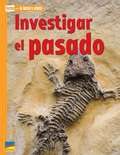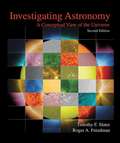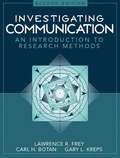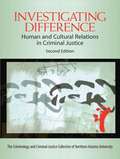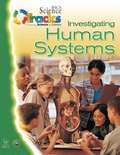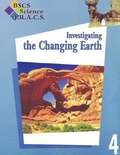- Table View
- List View
Inventos antiguos: Adelantados a su época (¡Arriba la Lectura!, Level T #34)
by John Francis Teresa TurnerLa gente lleva mucho tiempo inventando maneras de responder a los desafíos de la vida diaria. La gente del pasado tenía muchas de las necesidades básicas que hoy día resolvemos con inventos modernos. Encontraban maneras inteligentes de hacer las cosas más fácil y rápidamente. ¡Te sorprenderá saber lo avanzados que eran algunos de esos inventos! NIMAC-sourced textbook
Investigate Matter (Inspire Science, Grade 5 #Unit 1)
by McGraw-Hill EducationNIMAC-sourced textbook
Investigating Astronomy
by Jodi E. Asbell-Clarke Erin M. Bardar Teon E. Edwards Jefffrey F. LockwoodInvestigating Astronomy is the first comprehensive astronomy textbook written specifically for high school students. In writing this book, we have tried to include all the major topics in an astronomy course while also engaging you in hands-on investigations and using tools that will help you learn in an interactive and meaningful way. The book also focuses on scientific inquiry, the process of making scientific claims and supporting them with evidence, and using scientific reasoning to justify and revise those claims.
Investigating Astronomy: A Conceptual View of the Universe (Second Edition)
by Roger Freedman Timothy F. SlaterWith a careful selection of topics, a focus on conceptual understanding, and a strong theme of scientific process, Investigating Astronomy offers a compelling presentation for students learning introductory astronomy. The updated new edition includes cutting-edge research in the field and provides a contemporary view of the nature of science.
Investigating Biodiversity and Interdependence, Student Guide
by National Science Resources Center Amy Charles Max-Karl WinklerNIMAC-sourced textbook
Investigating Careers
by Suzanne Weixel Steve Mariotti Neelam Patel ChowdharyNIMAC-sourced textbook
Investigating Communication: An Introduction to Research Methods, Second Edition
by Lawrence R. Frey Carl H. Botan Gary L. KrepsInvestigating Communication teaches students how communication research is conducted from start to finish, with the text's organization modeled after a traditional research study.
Investigating Crayfish (SEEDS Book Reader)
by Catherine Halversen Siri FeeneyNIMAC-sourced textbook
Investigating Difference: Human and Cultural Relations in Criminal Justice
by Lynn C. Jones Criminal Justice Collective StaffInvestigating Difference examines the full range of individual differences across the entire criminal justice system. Moving beyond just race and gender, it tackles differences based on experience, age, socio-economic class, disabilities and more. Written by a variety of leaders in the field, it looks at how these variances impact all people within the system, including victims, offenders, and service providers. This edition continues to emphasize positive solutions and includes new "case-in-point" illustrations that discuss how difference matters. For anyone interested in the criminal justice system with regard to diversity and multicultural issues.
Investigating Digestion and Motion, Student Guide
by National Science Resources Center Wordwise Inc. Taina LitwakNIMAC-sourced textbook
Investigating Earth Science
by Dusty Girard Rick LynnInvestigating Earth Science is a lab manual designed to meet the requirements of an introductory geology course for non-science majors. <p><p> In order to meet the needs of a broad based geology course many topics are covered including the scientific method, mineral and rock formation and identification, water issues, coordinate systems and mapping, geologic time, the atmosphere, weather and climate, and astronomy. <p><p> This lab manual is designed to complement the lecture component of an introductory geology lecture course to reinforce and enhance student’s understanding of Earth processes, human interaction with our environment and the place of the Earth and humans in our solar system and universe. The major goal of this lab manual is to help students understand the importance of how science works, how scientists think and how science impacts the student’s life on a daily basis.
Investigating God's World (4th Edition)
by Matilda Nordtvedt Gregory Rickard Julie Rickard Stephen McalisterThe book investigates the things that you see every day and to know the laws that these objects of nature obey and how they all fit together in God's creation.
Investigating Life Systems 3rd Edition
by Kendall Hunt Pubishing Company[This book] introduces key ideas from the life sciences. In Unit 1, students examine systems that are in and out of balance and develop a conceptual understanding of systems. In Unit 2, they look at characteristics and causes of variations in populations. They study genetics and patterns of inheritance, as well as the ethical issues associated with genetic engineering. In Unit 3, they look at change in systems by studying the theory of evolution as an example of an idea that has changed over time, as well as a scientific explanation for changes in living organisms. By studying population systems in Unit 4, the students pull together all of these concepts related to living systems and focus on population growth in general, and the human population system specifically, to learn about the interrelationships that influence systemwide changes.
Investigating The Changing Earth
by Biological Sciences Curriculum StudyFour modules explore topics in physical science, earth and space science, life science, and science and technology with hands-on activities designed to engage students in the processes of scientific inquiry and technological design. Modules within a developmental level may be taught in any sequence.

